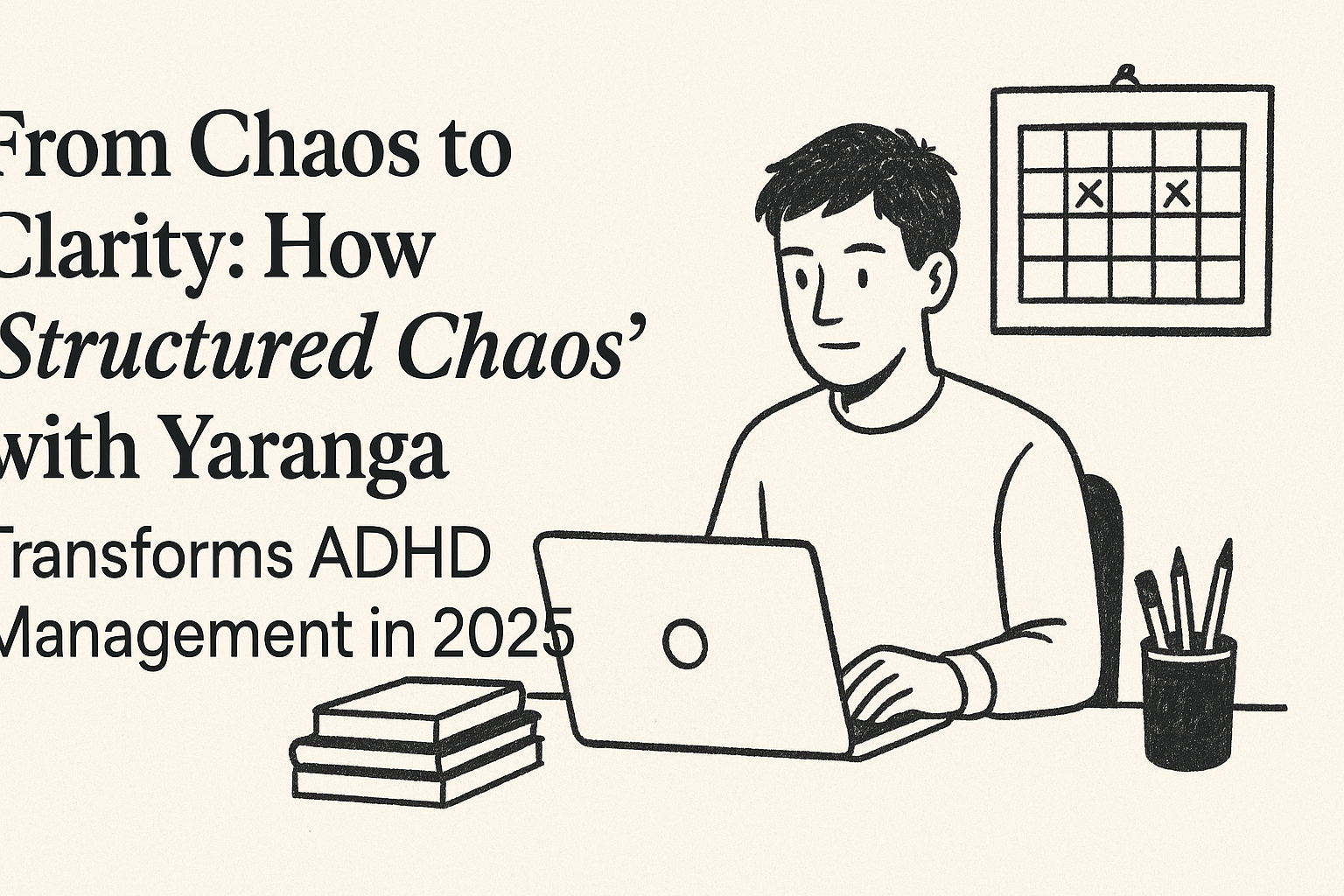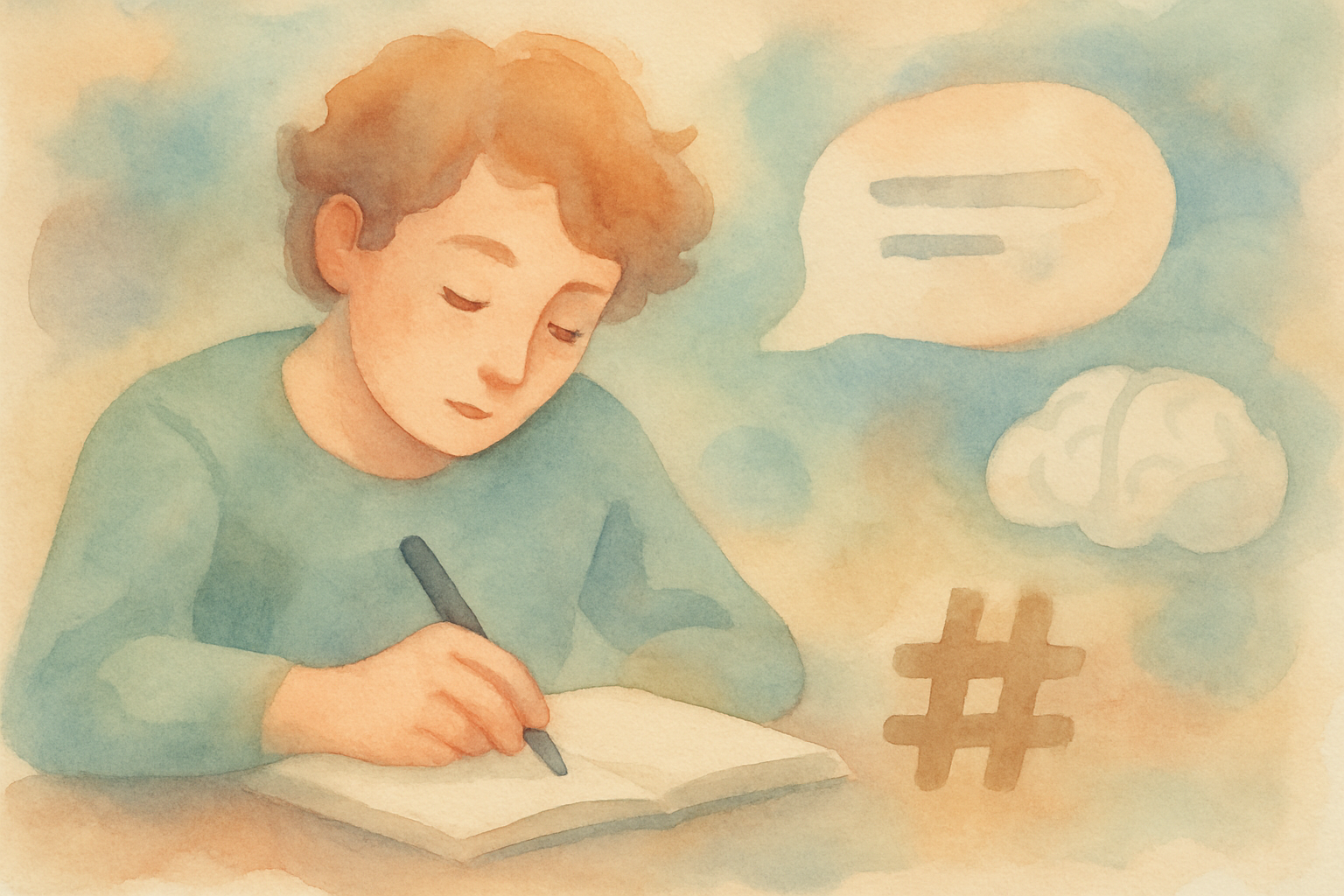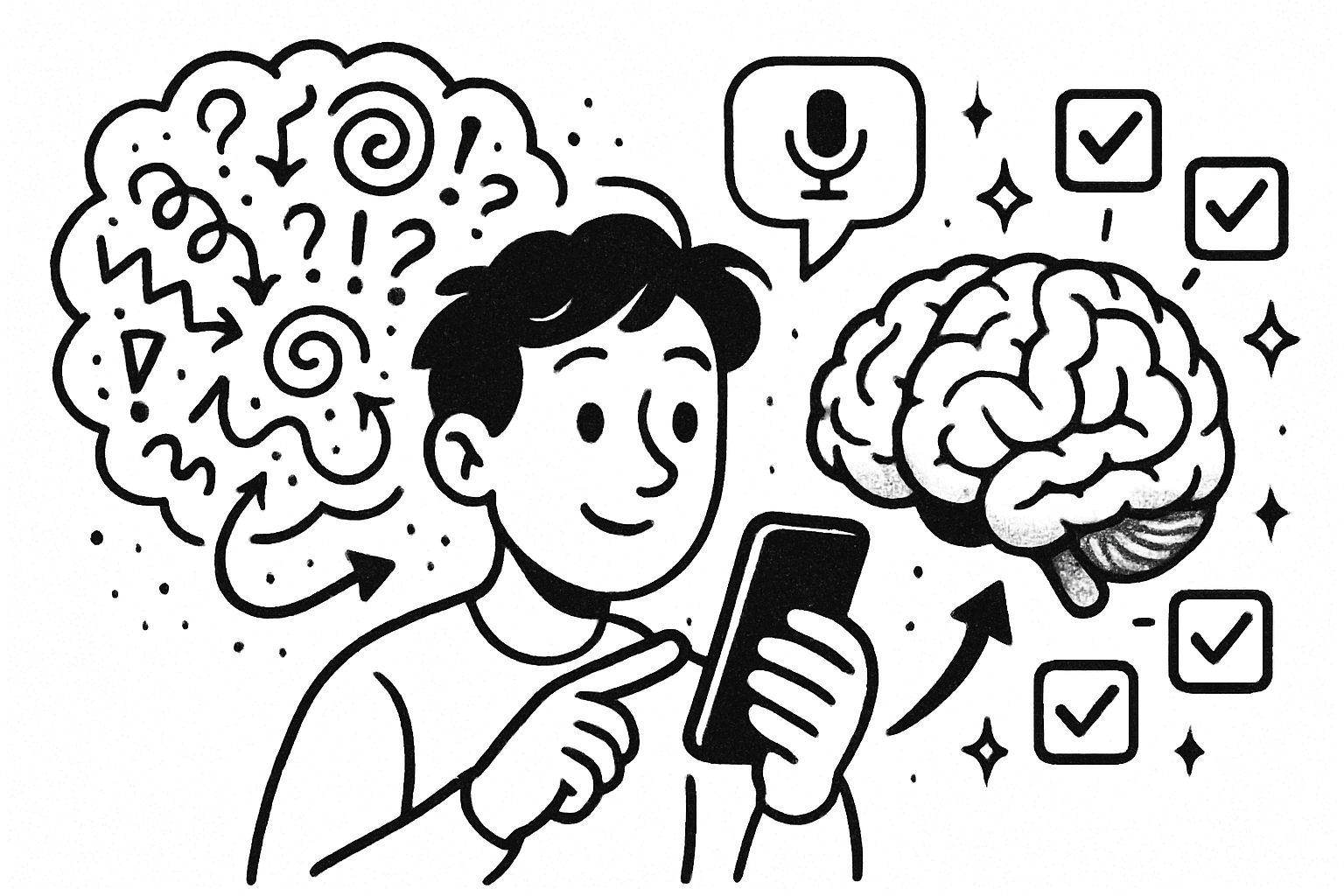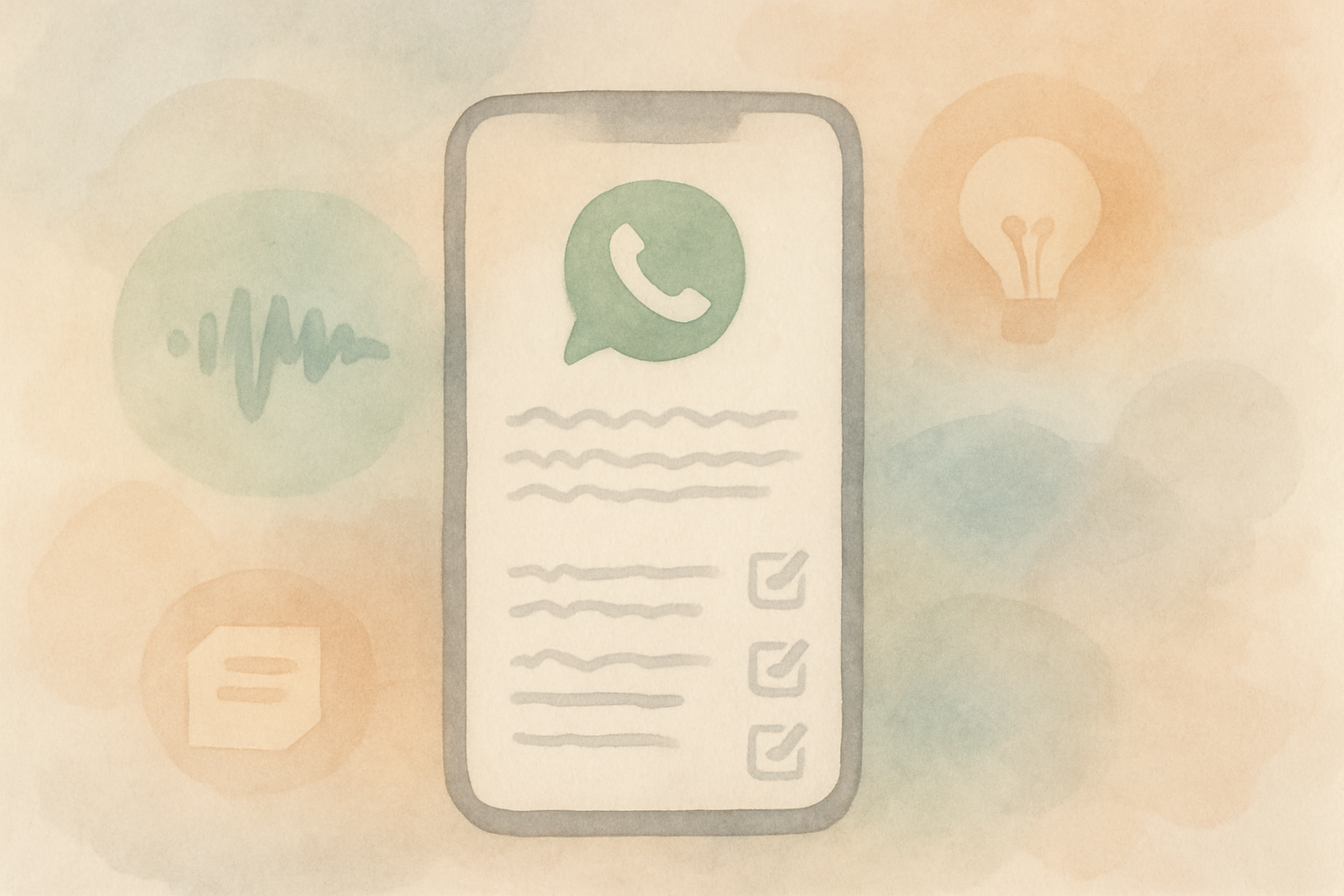How 'Structured Chaos' with Yaranga Transforms ADHD Management in 2025
Transform ADHD overwhelm into productivity with 'structured chaos.' Discover how Yaranga's revolutionary note-task integration eliminates folder paralysis, reduces mental clutter, and creates ADHD-friendly organization that actually works.

Picture this: You're staring at seventeen different apps on your phone, each promising to "fix" your ADHD organization problems. Your digital life looks like a tornado hit it – scattered notes in one app, forgotten tasks in another, and important ideas buried somewhere in a folder system you created but can't remember how to navigate.
Sound familiar? You're not alone. For millions with ADHD, traditional organizational systems feel like trying to force a wildflower garden into perfectly straight rows. The result? Overwhelming clutter, paralyzing indecision, and a constant battle against your own natural way of thinking. This struggle has real consequences – adults with ADHD face significantly higher rates of underemployment, often due to difficulties with task organization and executive function challenges that rigid systems can't address. [source]
But what if I told you the solution isn't another rigid system or productivity hack? What if the answer lies in embracing what I call 'structured chaos' – a revolutionary approach that works with your ADHD brain, not against it?
This is exactly what Yaranga was designed to do. Born from the understanding that ADHD minds don't think in straight lines, Yaranga creates a seamless ecosystem where your scattered thoughts become organized action, and your natural creativity becomes sustainable productivity.
Ready to discover how thousands of ADHD users are finally finding their organizational sweet spot? Let's dive into how 'structured chaos' can transform your daily reality from overwhelming to empowering.
Tired of fighting systems that don't fit your brain? Discover how Yaranga turns your natural thinking style into a productivity superpower. Try Yaranga Free
The Science Behind 'Structured Chaos': Why Your ADHD Brain Craves Flexible Order
Before we explore how Yaranga brings this concept to life, let's understand what 'structured chaos' actually means and why it's a game-changer for ADHD management.
'Structured chaos' isn't about embracing disorder – it's about creating intelligent flexibility. Think of it as the difference between a jazz improvisation and random noise. Jazz has structure (rhythm, key, chord progressions) but allows for creative freedom within that framework. Similarly, structured chaos provides just enough scaffolding to support your goals while honoring your brain's natural tendency toward non-linear, associative thinking.
Here's the crucial insight: ADHD brains are wired differently. While neurotypical brains often thrive with sequential, hierarchical organization, ADHD brains excel at making connections across seemingly unrelated concepts. We're natural systems thinkers, but traditional tools force us into linear boxes.
Research consistently shows that rigid organizational systems often fail for individuals with ADHD due to executive function differences in areas like task initiation, working memory, and cognitive flexibility. As noted by ADHD experts at Verywell Mind, "Embracing ADHD's natural thinking patterns can create productive order without overwhelming rigidity."
The key is leveraging what researchers call "ADHD cognitive strengths" – things like:
- Hyperfocus ability: When engaged, ADHD brains can maintain intense concentration
- Creative connections: Natural ability to link disparate ideas and see innovative solutions
- Dynamic thinking: Comfort with rapid mental shifts and multifaceted problem-solving
- Visual processing: Enhanced response to color-coding, visual cues, and spatial organization
Traditional productivity systems ignore these strengths, focusing instead on compensating for perceived weaknesses. Structured chaos flips this approach, building on what your brain does naturally while providing gentle guardrails for what it finds challenging.
Visual organization is particularly powerful for ADHD brains. Studies show that color-coding and visual cues can improve memory retention and task completion by up to 40% for individuals with ADHD – a principle that's deeply embedded in Yaranga's design philosophy. [source]
Want to see how others have transformed their approach? This video shows real ADHD organizational strategies in action:
Here's how structured chaos compares to traditional approaches:
| Aspect | Traditional Rigid Systems | 'Structured Chaos' with Yaranga |
|---|---|---|
| Mental Model | One right way to organize | Multiple paths to the same outcome |
| Learning Curve | Steep, requires behavior change | Gentle, adapts to existing patterns |
| Failure Response | "I'm bad at organization" | "Let me adjust the system" |
| Information Flow | Siloed, requires context switching | Connected, maintains mental flow |
| Cognitive Load | High (remembering rules and categories) | Low (follows natural thought patterns) |
| Long-term Sustainability | Often abandoned when life gets busy | Becomes more useful under pressure |
Ready to experience the difference? See how Yaranga's structured chaos approach can work with your unique thinking style. Explore Yaranga Features
Yaranga's Revolutionary Philosophy: Where Thoughts Meet Action Seamlessly
Now that you understand the 'why' behind structured chaos, let's explore the 'how.' Yaranga's core innovation lies in its integrated environment where notes and tasks don't just coexist – they dance together in perfect harmony.
Imagine this scenario: You're in a client meeting, jotting down ideas in your notes. Suddenly, you realize three of those ideas need follow-up actions. In traditional systems, you'd need to:
- Switch to your task app
- Remember what you wanted to add
- Type out context that's already in your notes
- Try to link it back to your original notes
- Hope you remember the connection later
With Yaranga, you simply highlight the relevant text and transform it into a task – instantly. The connection is preserved, the context is maintained, and your mental flow continues uninterrupted.
This seamless integration directly addresses what researchers call the "task initiation barrier" – one of the most challenging executive function hurdles for ADHD brains. Procrastination often isn't about laziness; it's about the overwhelming mental energy required to start. When the gap between thinking and doing becomes microscopic, that barrier practically disappears. [source]
Real-World Integration Examples
The Research Project: You're exploring a new business idea. Your research notes contain market insights, competitor analysis, and random "what if" thoughts. As you read, you can instantly convert promising directions into research tasks, schedule follow-up calls with contacts mentioned in your notes, and create project milestones – all without leaving your research flow.
The Meeting Follow-Up: During a team meeting, you capture everything in one note. Action items become tasks assigned to yourself or others, important dates become calendar reminders, and key decisions stay connected to the full context. When someone asks "Why did we decide that?" six months later, you have everything in one connected space.
The Creative Project: You're brainstorming ideas for a presentation. Your creative notes spawn research tasks, design to-dos, and scheduling items. The entire project ecosystem lives in one space, preventing the common ADHD experience of having brilliant ideas that somehow never translate into completed projects.
This approach dramatically reduces what psychologists call "cognitive switching costs" – the mental energy lost every time you jump between different contexts or applications. For ADHD brains, which already struggle with working memory and attention regulation, minimizing these costs is crucial for maintaining productivity and reducing overwhelm.
Experience the magic of seamless integration – see how your thoughts can flow directly into action. Sign Up for Yaranga
Conquering 'Folder Paralysis': The Hidden ADHD Productivity Killer
Let me paint a picture that might feel painfully familiar: You have an important document to save. You open your file system and stare at dozens of folders. Does this go in "Work Projects" or "Client Materials"? Should you create a new folder? What if you can't find it later? Five minutes pass. Ten minutes. You've spent more time deciding where to put the file than creating it.
Welcome to 'folder paralysis' – the organizational quicksand that traps ADHD brains in decision-making loops. It's the reason many of us have desktops cluttered with files we were "too paralyzed to organize properly" and why important information often gets lost in the organizational void.
This isn't a character flaw or laziness – it's a predictable response to systems that demand categorical thinking from brains that excel at associative thinking. Traditional folder hierarchies force you to make a single "correct" choice about where information belongs, but ADHD brains naturally see multiple valid connections and relationships.
The Psychology Behind Folder Paralysis
Folder paralysis stems from several cognitive challenges common in ADHD:
- Decision fatigue: Having to make numerous organizational micro-decisions depletes mental energy
- Perfectionism anxiety: Fear of making the "wrong" organizational choice leads to analysis paralysis
- Working memory overload: Trying to remember multiple folder systems while focusing on the actual work
- Category rigidity stress: Anxiety about information that could logically fit in multiple places
Research in digital decluttering shows that simplified organizational systems significantly reduce stress and improve task completion for individuals with ADHD. The key is moving from "perfect categorization" to "functional retrieval" – focusing on finding information quickly rather than storing it "correctly." [source]
Yaranga's Liberation Strategy
Yaranga breaks free from folder tyranny through several innovative approaches:
Multi-Dimensional Tagging: Instead of forcing information into single categories, use multiple tags that reflect different aspects or contexts. Your client meeting notes might be tagged with the client name, project type, meeting date, and key topics discussed. This mirrors how your brain naturally categorizes information – by multiple, interconnected associations.
Intelligent Search: Yaranga's search doesn't just look for titles – it searches through your actual content, tags, and connections. You can find that important note by remembering a single phrase, a person mentioned, or even just the general topic area.
Visual Connection Mapping: See how your notes and tasks connect to each other visually. This helps combat the ADHD struggle with "object permanence" for information – if you can't see it, it might as well not exist.
Context-Sensitive Organization: Information can appear in different organizational views depending on what you're working on. Your research notes about a client project can show up in your client view, your project timeline view, and your industry research view simultaneously.
Understanding why traditional organization fails can help you break free. This video explains the ADHD challenge of "clutter blindness":
This approach aligns with what professional ADHD coaches teach their clients – building personalized systems that leverage individual strengths rather than forcing conformity to universal "best practices." The goal is creating what experts call "functional organization" – systems that actually work in real life, not just in theory. [source]
Ready to escape folder paralysis forever? Try Yaranga's flexible, tag-based organization system. Get Started with Yaranga Tags
Proven Strategies: Turning ADHD Challenges into Productivity Superpowers
Now that we've covered the foundational concepts, let's get practical. How do you actually use Yaranga's structured chaos approach to transform your daily productivity? Here are battle-tested strategies developed by ADHD users who've found their groove with the system.
The "Brain Dump to Action" Method
One of the most powerful features of ADHD brains is our ability to generate ideas – lots of them, often simultaneously. The challenge is capturing and channeling this creativity productively.
Start your day with a "brain dump" session in Yaranga. Open a new note and spend 10-15 minutes writing everything that's on your mind – worries, ideas, tasks, random thoughts. Don't organize or filter; just capture.
Then, go through your brain dump and convert actionable items into tasks directly within the same note. The beauty is that the tasks remain connected to the original context, so you never lose the "why" behind each action item.
Pro tip: Use voice-to-text features during your brain dump to capture thoughts at the speed of thinking, then refine them into actionable tasks during a focused review session.
The "Project Ecosystem" Approach
Instead of scattered project files across multiple applications, create a "project ecosystem" within Yaranga. Each major project gets its own space that includes:
- Initial brainstorming and planning notes
- Research and reference materials
- Meeting notes and communications
- Task lists and milestones
- Review and reflection notes
Everything connects fluidly, so you can move from strategic thinking to tactical execution without losing momentum or context.
Enhanced Focus with the "Modified Pomodoro" Technique
The traditional Pomodoro Technique (25 minutes focused work, 5-minute break) can be challenging for ADHD brains because it fights against natural hyperfocus cycles. Here's how to adapt it with Yaranga:
Flexible Time Blocks: Instead of rigid 25-minute periods, work in natural focus chunks. When you feel your attention waning, take a break. Yaranga's integrated environment means you can seamlessly resume exactly where you left off.
Context Preservation: Keep all materials for your focus session in one Yaranga workspace. This eliminates the common ADHD experience of losing your train of thought while searching for relevant information.
Transition Notes: Before breaks, quickly note where you were and what comes next. This external memory helps you restart focus sessions without the typical "What was I doing?" confusion.
The Pomodoro Technique's effectiveness for ADHD has been well-documented, particularly when adapted to work with hyperfocus patterns rather than against them. [source]
The "Connection Web" Strategy
ADHD brains excel at seeing connections that others miss. Leverage this strength by creating explicit connections between related notes and tasks in Yaranga. When working on any project, regularly ask:
- What other projects or ideas does this relate to?
- What past experiences or knowledge can inform this work?
- What future opportunities might this create?
Create these connections actively within Yaranga. Over time, you'll build a rich knowledge web that makes you incredibly effective at synthesis and strategic thinking.
Visual Progress Tracking
ADHD brains often struggle with motivation when progress feels invisible. Yaranga's visual progress indicators help combat this by making advancement tangible and rewarding.
Use color coding strategically: red for urgent tasks, green for completed items, yellow for in-progress work. Create visual dashboards that show your momentum across different areas of life. Celebrate small wins explicitly – they're not trivial; they're fuel for sustained effort.
Ready to turn your ADHD traits into productivity advantages? Start implementing these strategies with Yaranga today. Yaranga Focus Tools Guide
Real Success Stories: ADHD Users Thriving with Structured Chaos
The proof of any system lies in real-world results. Here are stories from ADHD users who've transformed their productivity using Yaranga's structured chaos approach:
Sarah, Marketing Director: "I used to have sticky notes everywhere, three different task apps, and constant anxiety about forgetting something important. With Yaranga, my creative brainstorming sessions flow directly into project management. I haven't missed a deadline in eight months, and my team says I'm more organized than neurotypical colleagues."
Mike, Freelance Designer: "The game-changer was having client communications, creative notes, and project tasks all in one space. I can jump from inspiration to execution instantly. My ADHD hyperfocus is now a superpower instead of a source of forgotten responsibilities."
Dr. Jennifer Chen: "As a researcher with ADHD, I was drowning in disparate notes and losing track of important connections between ideas. Yaranga's linking system mirrors how my brain actually works. My research productivity has doubled, and I'm finally publishing at the rate I knew I was capable of."
The Science of Sustainable Change: Making Structured Chaos Stick
Implementing a new organizational system can feel overwhelming, especially when you've tried and abandoned many systems before. The key to making structured chaos work long-term lies in understanding the psychology of sustainable habit change for ADHD brains.
Start Stupidly Small: Don't try to organize your entire life overnight. Begin with one small area – maybe just capturing daily to-dos in Yaranga for a week. Let success build momentum.
Design for Your Worst Days: The system needs to work when you're stressed, tired, or overwhelmed – exactly when you need it most. Structured chaos is forgiving; it doesn't break when you don't follow it perfectly.
Leverage Hyperfocus Strategically: When you get excited about organizing, use that energy to set up systems, not to do all the organizing. Create templates, workflows, and structures that will support you during lower-energy periods.
Combine with Professional Support: Yaranga works exceptionally well alongside therapy approaches like Cognitive Behavioral Therapy (CBT), which helps reframe perfectionist thinking patterns that can sabotage organizational efforts. When combined with proper therapeutic support, tools like Yaranga become even more powerful for improving executive function and daily life management. [source]
Your Journey from Chaos to Clarity Starts Now
The path from overwhelming chaos to productive clarity isn't about forcing your ADHD brain into neurotypical boxes. It's about creating systems that celebrate your cognitive strengths while providing gentle support for your challenges.
Structured chaos isn't a compromise – it's an optimization. It's recognizing that your brain's tendency toward non-linear thinking, creative connections, and dynamic problem-solving are features, not bugs. The goal isn't to think like everyone else; it's to think like yourself, but with better tools.
Yaranga's integrated approach to notes and tasks creates the perfect environment for this transformation. By eliminating artificial barriers between thinking and doing, between planning and executing, between capturing ideas and taking action, it creates space for your natural cognitive style to flourish.
The benefits extend far beyond simple organization. Users report:
- Decreased anxiety about forgetting important information
- Increased confidence in professional settings
- Better work-life balance through efficient information management
- Enhanced creativity through reduced cognitive overhead
- Improved relationships due to better follow-through on commitments
Remember: the goal isn't perfection. It's progress. It's turning your beautiful, chaotic, creative ADHD brain into a powerhouse of intentional action and meaningful achievement.
Evidence-Based Resources and Further Research
For those interested in diving deeper into the research and methodologies behind ADHD-friendly productivity strategies, here are authoritative resources that support and expand on the concepts discussed in this article:
| Resource Type | Description | Link |
|---|---|---|
| Official Yaranga Platform & Research | Comprehensive platform documentation detailing ADHD-focused design principles, integration methodologies, and user research findings. Yaranga actively collaborates with researchers studying digital tools for executive function support. | yaranga.net Research collaboration: research@yaranga.net |
| Community Reviews & Launch Coverage | Independent product reviews and community feedback highlighting real-world usage patterns, user success stories, and practical implementation strategies from the ADHD community. | Product Hunt Reviews Community Insights |
| ADHD Productivity Research | Comprehensive analysis of digital productivity tools specifically designed for ADHD brains, including research on focus enhancement, task breakdown strategies, and cognitive load reduction techniques. | ADHD Productivity Apps Research |
| 2025 ADHD Tools Guide | Current research on mindfulness, journaling, and digital tool integration for adult ADHD management, emphasizing evidence-based approaches to reducing mental clutter and building sustainable routines. | 2025 ADHD Management Tools |
| Executive Function Support | Academic and clinical resources on executive function challenges in ADHD, including task initiation, working memory support, and evidence-based intervention strategies that complement digital tools. | Executive Function Research |
Ready to Transform Your ADHD Chaos into Productive Clarity?
Join thousands of ADHD users who've discovered their organizational sweet spot with Yaranga. Experience the power of structured chaos – where your thoughts flow seamlessly into action, and your natural creativity becomes sustainable productivity.
Start your transformation today – your future organized self will thank you. Join Yaranga Today




